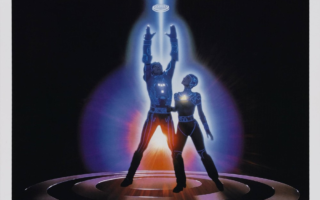Peter Gabriel: Secret World Live
Blu Ray and DVD (also available as Digital Video)
Eagle Vision
Total Running Time: 135 minutes (including extras)
Our Rating: 4.5 out of 5 stars
The process of Peter Gabriel creating a follow-up to 1986’s critically-acclaimed “So”, an album that ushered in a global audience for the former Genesis front man, must have been akin to Michael Jackson trying to follow up “Thriller”.
“Sledgehammer”. “In Your Eyes”. “Big Time”. “Don’t Give Up”. “Red Rain”. They’re ALL on “So”. Talk about daunting.
Six years later, “Us” was released and although it wasn’t the uber hit-generator that “So” wound up being, it was one that was artistically more layered and emotionally richer. The subsequent “Secret World” tour that was launched a year later also upped the ante in terms of theatrics and stage presentation. Gabriel collaborated with Canadian playwright, actor and director, Robert Lepage, to create a show that that went beyond the simple definition of a live concert to one that was a journey through the heart and soul of the songs that comprised it. The set was a fairly elaborate one: a large square stage and a smaller circular one connected by a conveyor belt. Throughout the show, band members could travel between the two areas or use both to maximize the effect of any song’s individual scale: grand (“Steam”) or intimate (“Don’t Give Up”). A large screen suspended to an overhead tram allowed for a variety of abstract images to be projected onto it or, in one of the show’s most memorable visual moments, for a silhouette of Gabriel to expand and contract in time with the sound of slow respiration. At the end of the show, hidden trapdoors allowed Gabriel to literally pack up his superlative back-up band in a suitcase and disappear under a slowly-descending dome. For a show that was largely analog in nature, it was a true spectacle with a “wow” factor that buried the needles.
Unfortunately, the filmed version of the “Secret World” tour proceedings never received the home video treatment that it truly deserved. The 1994 VHS edition was limited both by that media’s low resolution and trapped within the confines of a standard 4:3 aspect ratio. The laserdisc, also released in 1994, benefitted from that format’s increased resolution, but suffered from the horizontally compact presentation – as well as that technology’s near-dead-on-arrival fate.
With the advent of DVD, “Secret World Live” was reissued in 2003. Touting itself as a “widescreen re-mixed and re-mastered” version, the disc wound up being a huge disappointment to viewers due to the video being extremely pale, grainy and lossy – so bad, in fact, that many fans (this reviewer included) were glad that they had held onto their videocassette copy. It was that bad.
The recent DVD reissue and first-time Blu-ray issue of “Secret World Live” finally let the luminance and brilliance of the Macedonia, Italy stop on the European leg of the tour shine in full. Both the visual and audio components of the film have been cleaned-up and bolstered to a degree that the earlier editions can now safely be sold off on eBay or, better yet, used as a cutting boards, serving trays and drink coasters. Interestingly enough, as was true with the initial “widescreen” DVD, it appears that both of the new editions are also cropped versions of the original film which was shot in 16mm. The extent to which the shots are cropped varies shot-by-shot. In most instances, the widescreen version allows us to see more of the horizontal picture at the expense of the vertical. Given that both the 4:3 (1.33:1) and the 16:9 (1.77:1) versions seem to missing image content that was clearly present in the original negative (see comparison pictures), it makes one wonder if “Secret World Live” will be reissued again at some point in the future as an edition that accurately reflects the aspect ratio (1.85:1) that it was actually filmed in.
While both the Blu-ray and the reissued DVD have substantially better picture quality than any of their predecessors, the difference between them is fairly insubstantial. “Secret World Live” wasn’t filmed in high-definition, so the 1080i spec listed on the back of the Blu-ray case might falsely raise expectations that the Blu’s presentation will be super-clear and crisp which isn’t really the case. Both the 2012 releases correct the grain and pixelation of the earlier editions not by upping the sharpness but, rather, smoothing out the overall image. The net result is a softer picture than one might hope for but one that is far-and-away the best we’ve seen to date. If the A/V buck stops here with “Secret World Live”, fans should easily be satisfied with the outcome.
The best enhancement that the 2012 editions offer up is superior sound quality. The DVD offers threeoptions: Dolby Digital Stereo, Dolby Surround 5.1 and DTS Digital Surround for the DVD. The Blu-ray carries two: LPCM Stereo and DTS HD Master Audio (inexplicably, Dolby options are absent). Both are plenty punchy and detailed – especially the Blu’s DTS track.
The same bonus features that found their way onto the 1994 DVD are also on the 2012 releases – save for the somewhat out-dated “film taster of Peter Gabriel’s ‘Growing Up’ tour” which has been replaced by a 2011 performance of “The Rhythm of the Heat” with the New Blood Orchestra (itself a teaser for Gabriel’s recently-released “Live Blood” DVD and Blu-ray).
Is it worth it to pick up a copy of this now 19-year old concert? You betcha. With “Secret World Live”, Peter Gabriel and his team of esteemed colleagues managed to create a depth of atmosphere and varied mood that live concerts viewers seldom see.
Is it worth the re-buy? Ditto. Emphasis on “see”.


